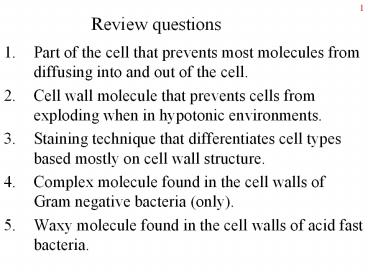Review questions PowerPoint PPT Presentation
Title: Review questions
1
Review questions
- Part of the cell that prevents most molecules
from diffusing into and out of the cell. - Cell wall molecule that prevents cells from
exploding when in hypotonic environments. - Staining technique that differentiates cell types
based mostly on cell wall structure. - Complex molecule found in the cell walls of Gram
negative bacteria (only). - Waxy molecule found in the cell walls of acid
fast bacteria.
2
Gram Negative Gram Positive
http//www.conceptdraw.com/sampletour/medical/Gram
NegativeEnvelope.gif http//www.conceptdraw.com/sa
mpletour/medical/GramPositiveEnvelope.gif
3
Gram negative cell wall
http//student.ccbcmd.edu/courses/bio141/lecguide/
unit2/bacpath/gncw/u1fig10b.html
4
Features of the outer membrane
- Assymetric
- The layer facing inward is phospholipids, but the
outer layer of the lipid bilayer is
lipopolysaccharide - Proteins
- Porins, 3 subunit proteins that transport
substances through the membrane - Other proteins with other functions
- Brauns lipoprotein, attaches to peptidoglycan
5
Structure of LPS
Unique to different bacteria.
Takes place of hydrophilic head group.
www.med.sc.edu85/fox/ cell_envelope.htm
6
Why is the outer membrane important?
- To the bacterium
- Additional barrier to diffusion of unwanted
substances such as antibiotics. - Barrier to enzymes that could harm the cell such
as lysozyme. - Lipid A portion called endotoxin, harmful to host
- Proteins help bacteria
- Attach to host cells to cause disease.
- Enter host cells to cause disease.
- To us
- Triggers host defenses, immune recognition
7
Periplasmic Space
Location of many useful proteins.
www.arches.uga.edu/emilyd/ theory.html
8
Glycocalyx capsules and slime layers
Sugar covering capsules are firmly attached,
slime layers are loose.
Multiple advantages to cells prevent
dehydration absorb nutrients protection from
predators, WBCs protection from biocides (as
part of biofilms) attachment to surfaces and
site of attachment by others.
cell
capsule
In some bacteria, a covering outside the cell is
made of proteins, e.g S-layers.
www.activatedsludge.info/ resources/visbulk.asp
9
Fimbriae and pili
Both are appendages made of protein Singular
fimbria, pilus Both used for attachment Fimbriae
to surfaces (incl. host cells) and other
bacteria. Pili to other bacteria for exchanging
DNA (sex).
www.ncl.ac.uk/dental/oralbiol/ oralenv/images/sex1
.jpg
10
Fimbriae and pili-2
http//www.mansfield.ohio-state.edu/sabedon/006pi
li.gif
11
Flagella
- Flagella protein appendages for swimming through
liquid or across wet surfaces. - Rotate like propellers.
- Different from eukaryotic flagella.
- Arrangements on cells
- polar,
- Lophotrichous,
- amphitrichous,
- peritrichous.
www.ai.mit.edu/people/ tk/ce/flagella-s.gif
www.bmb.leeds.ac.uk/.../icu8/ introduction/bacteri
a.html
12
Flagellar structures
Differences Thickness and structure Membrane or
not Whip or spin
www.scu.edu/SCU/Departments/ BIOL/Flagella.jpg
img.sparknotes.com/.../monera/ gifs/flagella.gif
13
Motility revisited
- Flagella protein appendages for swimming through
liquid or across wet surfaces. - Axial filament a bundle of internal flagella
- Between cell membrane and outer membrane in
spirochetes - Filament rotates, bacterium corkscrews through
medium - Gliding
- No visible structures, requires solid surface
- Slime usually involved.
14
Axial filaments
http//images.google.com/imgres?imgurlhttp//micr
ovet.arizona.edu/Courses/MIC420/lecture_notes/spir
ochetes/gifs/spirochete_crossection.gifimgrefurl
http//microvet.arizona.edu/Courses/MIC420/lecture
_notes/spirochetes/spirochete_cr.htmlh302w400
sz49tbnidBOVdHqepF7UJtbnh90tbnw119start1
prev/images3Fq3Daxial2Bfilament2Bbacteria26
hl3Den26lr3D26sa3DG
15
Review of eukaryotic cells
www.steve.gb.com/ science/cell_biology.html
16
Eukaryotic cell reminders
- Eukaryotic cells have a variety of compartments
- Membrane-bound organelles, carry out functions
- DNA in nucleus. NO NUCLEUS in Prokaryotes!
- Mitochondrion is an enslaved bacterium
- Inner and outer membrane like a Gram bacterium
- Mitochondrion has its own DNA and ribosomes
- It is the same size as a bacterium.
- Lysozome is an organelle
- Contains various digestive enzymes
- Important part of WBCs defenses against bacteria
17
How things get in (and out) of cells
- Eukaryotic cells
- Have transport proteins in membrane
- Have a cytoskeleton made of microtubules
- Allows for receptor mediated endocytosis,
phagotcytosis, etc. - Cell membrane pinches in, creates vesicle
- Prokaryotic cells
- Can NOT carry out endocytosis
- Have a stiff cell wall
- Cytoskeleton newly discovered, not substantial
- Entry of materials into cell by diffusion or
transport processes ONLY.
18
Illustrations entry into cells
Both prokaryotes and eukaryotes.
Only eukaryotes.
http//bio.winona.msus.edu/bates/genbio/images/end
ocytosis.gif http//www.gla.ac.uk/jmb17n/Teaching
/JHteaching/Endocytosis/figures/howdo.jpg
19
Type of molecule affects transport
- Small molecules can pass through a lipid bilayer
- Water otherwise, no osmosis
- Gases such as O2 and CO2
- Lipid molecules can
- Dissolve in lipid bilayer, pass through membrane
- Many antibiotics, drugs are lipid soluble
- Larger, hydrophilic molecules cannot
- Ions, sugars, amino acids cannot pass through
lipids - Transport proteins required
20
Transport through membranes
- Simple diffusion
- Molecules travel down concentration gradient
- Membrane is not a barrier to their passage
- Facilitated diffusion
- Molecules travel down concentration gradient
- Cannot pass through lipid bilayer their passage
is facilitated by protein transporters - Active transport
- Molecules travel against concentration gradient
- Requires input of metabolic energy (ATP),
transporter
21
How molecules get through the membrane
http//www.rpi.edu/dept/chem-eng/Biotech-Environ/M
embranes/bauerp/diff.gif
22
ATP is not always used directly in active
transport
- An electrochemical gradient exists across the
cell membrane (membrane potential) - Positive just outside the membrane, negative
within - Gradient in the form of H ions
Maintained by the hydrolysis of ATP or by the
same metabolic reactions that make ATP Powers
uniports, symports and antiports
23
Uniport
- Transport of a single substance
- Example transport of K into the cell
- Against its chemical gradient, but down its
electrical gradient. - (red ball K)
- Doesnt require energy DIRECTLY, but making
theelectrical gradient DOESrequire energy. - Antiport and Symport
- Are other examples

